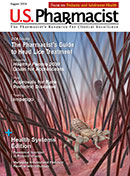US Pharm. 2024;49(8):8-12.
ABSTRACT: Impetigo is a common bacterial skin infection that is primarily caused by two pathogens: Staphylococcus aureus and Streptococcus pyogenes. Its highly contagious nature poses a health concern, especially among young children. Impetigo is divided into two main variants: nonbullous and bullous. Diagnosis is often made based on the clinical presentation and supplemented by cultures. While impetigo may be self-resolving, nonpharmacologic, topical, or oral antimicrobial treatment may be used to relieve symptoms, prevent the formation of new lesions, and avoid complications. Pharmacists play an essential role as frontline healthcare professionals in identifying, treating, and managing impetigo and providing patient education while collaborating with other healthcare professionals for optimal care.
Impetigo is a superficial bacterial skin infection occurring most commonly in children aged 2 to 5 years, but it can affect a person of any age. It is a highly contagious skin disorder that easily spreads through close contact, especially among siblings and children in daycare centers and schools.1 Historically, the primary organisms causing impetigo have been Staphylococcus aureus, group A beta-hemolytic Streptococcus pyogenes, or both. Impetigo may also occur as a secondary infection due to insect bites, eczema, or herpetic lesions. Approximately one-third of skin and soft tissue infections of returning travelers are attributed to impetigo, often secondary to mosquito bites. Underlying systemic conditions such as diabetes, eczema, and HIV/AIDS may increase susceptibility to impetigo.2,3 The infection is most common in hot, humid weather, facilitating microbial skin colonization. Additional risk factors for impetigo include minor trauma to the skin, such as cuts or scrapes, allowing the entry of organisms into the superficial layers of skin and causing infection.1 Poor personal hygiene, such as improper handwashing, body washing, and facial cleanliness, also increases the risk of impetigo.
Clinical Presentation
Generally, impetigo most commonly presents as erythematous (red, inflamed) skin lesions that burst and progress to a yellow-brown crustation that is left behind. This may be itchy or painful.4 Clinical manifestations divide impetigo into two main variants: nonbullous and bullous (see TABLE 1). Seventy percent of cases are nonbullous form, and 30% of cases are bullous. Impetigo is highly contagious and can easily spread through close contact or when sharing personal items.
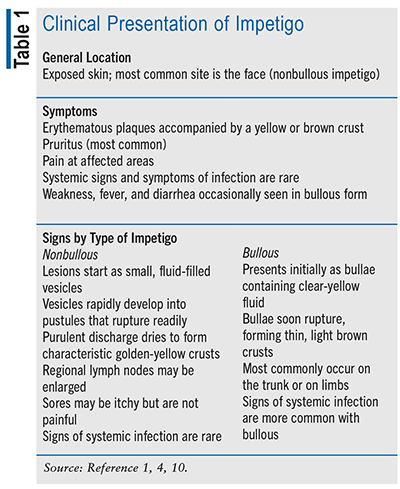
Nonbullous impetigo starts as papular lesions that transition into pustules that quickly rupture, allowing thick, purulent discharge that forms golden-yellow crusts, leaving the skin red and raw where the sores have broken open. The skin often heals without scarring unless scratching cuts deep into the skin.5 It is usually caused by S aureus, but S pyogenes may also be involved, especially in warmer, humid climates.2 The process that the lesions go through occurs over approximately 1 week. Nonbullous impetigo commonly affects the face and extremities.6
Bullous impetigo is most commonly found on the trunk, axilla, extremities, and intertriginous areas, and fewer lesions are found compared with nonbullous impetigo. This type of impetigo is caused solely by S aureus capable of producing exfoliative toxins.1 Bullous impetigo initially presents as large, flaccid bullae filled with clear-yellow fluid. Once ruptured, a thin, brown crust is left behind. There is no redness on the surrounding skin.5
Identifying and Triaging
Impetigo can be mistaken for other blistering and rash disorders (see TABLE 2).2 Skin conditions that share features with nonbullous impetigo are inflammatory conditions that present locally, such as contact dermatitis, tinea infection, and herpes simplex virus. However, if a golden crust is seen, impetigo should be suspected. Bullous impetigo is differentiated from other blistering skin conditions, such as insect bites, acute contact dermatitis, and thermal burns. The characteristic difference is that bullous impetigo transitions from bullae to erosions with a peripheral crust.
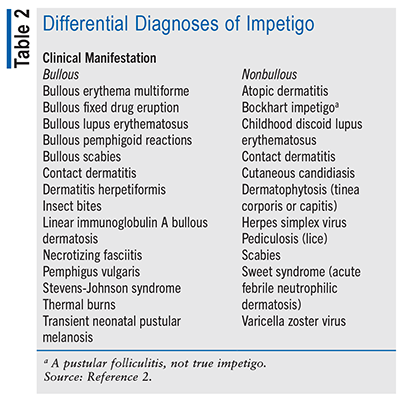
Identifying impetigo is often based on clinical manifestations (see TABLE 3). Gram stain and culture of the pus or excretions from skin lesions of impetigo may be recommended to help identify whether S aureus and/or beta-hemolytic Streptococcus is the cause.7 The culture may also be helpful for antimicrobial susceptibilities. Serologic testing for streptococcal antibodies is not necessary for the diagnosis of impetigo.
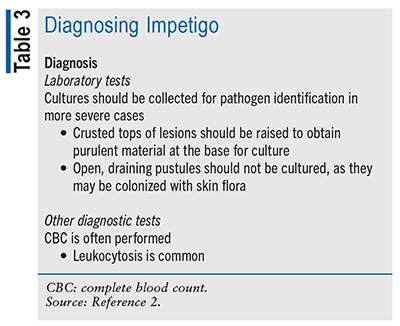
Pharmacists, especially in the community setting, are often one of the first points of contact for people who suspect that they have impetigo and are equipped with the knowledge to identify, triage, and provide patient guidance and counseling. After assessing the patient, if impetigo is identified, pharmacists should promptly recommend treatment of the infection or refer patients to a prescriber in areas where pharmacist-led therapy is restricted. Regardless, pharmacists should educate patients on how to prevent the spread of the infection and avoid further complications.
Management and Treatment
The treatment goals of impetigo include resolving symptoms and discomfort, limiting the spread of infection, improving cosmetic appearance, and preventing recurrence.1 Twenty percent of cases resolve spontaneously without treatment, typically in 14 to 21 days.4 However, there is a risk of worsening infection and developing complications and causing ecthyma, a more serious form of impetigo that results in ulcerative sores that go deeper into the layers of the skin when left untreated.3 Because ecthyma goes deeper into the skin, scars may form as it heals. This is more common in children. Although impetigo may be a self-limiting condition, dermatologists often prescribe antimicrobial treatment, and adjunctive skin care is recommended to relieve symptoms, prevent the formation of new lesions, and prevent complications.8 Oral or topical antibiotics may be prescribed for both bullous and nonbullous impetigo (see TABLE 4). However, oral therapy is recommended only for patients with numerous lesions or in outbreaks affecting several people, to decrease the transmission of infection.
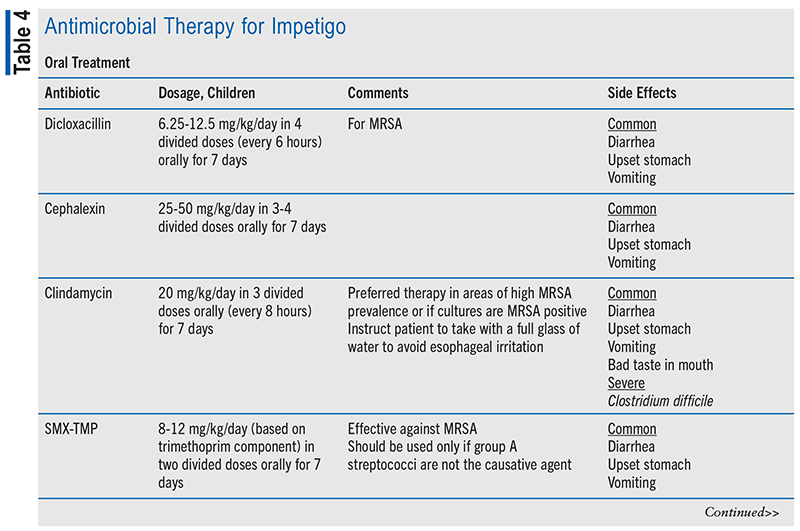

Topical treatment for impetigo should include mupirocin two to three times daily for 5 days. Retapamulin was previously available for the treatment of impetigo but is no longer available in the United States. Prior to application, the crust should be removed with soap and water. It is important for patients to be reevaluated after 3 to 5 days of therapy with mupirocin to ensure efficacy. If the patient does not respond within 5 days, therapy should be altered. Mupirocin is generally well tolerated, but side effects may include skin irritation.9 A disadvantage of topical treatment is that application may be difficult if lesions are widespread.10 Oral therapy should include an agent with coverage for S aureus for a duration of 7 days. Usually, S aureus isolates from impetigo are methicillin susceptible, so dicloxacillin or cephalexin is recommended. Both medications may cause diarrhea, upset stomach, and vomiting.11,12 In cases where the culture yields streptococci alone, the patient can be treated with oral penicillin. When methicillin-resistant S aureus is suspected or confirmed or if the patient is penicillin-allergic, clindamycin or sulfamethoxazole-trimethoprim is recommended.7 Clindamycin has a high risk of causing Clostridium difficile infection, which may happen during or a few months after taking the course. Patients should be counseled to seek further workup by their prescriber if stomach pain, cramps, or very loose, watery, or bloody stools occur.13 Common side effects of sulfamethoxazole-trimethoprim include diarrhea, upset stomach, and vomiting.14 When taking antibiotics, whether topical or oral, it is imperative for pharmacists to emphasize the need to continue using the treatment for the prescribed course, even if the infection seems to have been cleared. If symptoms have not resolved or have worsened within 7 days, the patient should be reassessed to rule out differential diagnoses as aforementioned.10
Skin care also plays a vital role in clearing and preventing impetigo (see TABLE 5). Soaking the affected skin area in warm water and soap and gently removing dirt and crusts may aid in symptomatic relief. In addition, covering the affected skin area will help it heal and prevent spreading the infection to others. If a child gets impetigo frequently, a dermatologist may recommend adding bleach to the child’s bath to reduce bacteria on the skin and prevent new infections and provide guidance on the appropriate amount to use.8 Since children are more likely to spread the infection through close physical contact, such as during playtime, it would be prudent for them to remain home from school for at least 24 to 48 hours after starting antibiotic therapy.4 Adolescents may not need to stay home, as they typically manage hygiene and follow precautions to minimize transmission better than younger children. Direct skin-to-skin contact with others, including situations such as playing contact sports and sharing equipment or clothing, should be avoided. Affected areas should be kept covered with gauze bandages and tape, and hands should be washed often, especially after touching or treating the infected skin to avoid infecting others.8
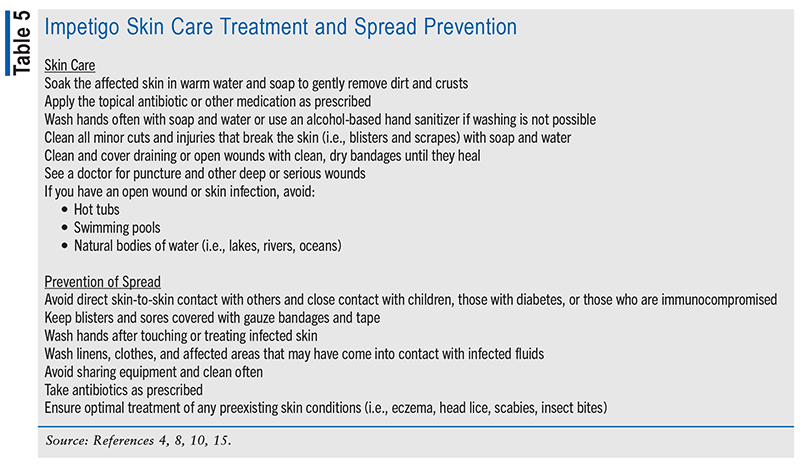
Role of the Pharmacist
Conveniently located in community settings, pharmacists are accessible resources. They are in an ideal position for identifying impetigo, referring patients to a doctor when necessary, and providing personalized care and education to prevent the spread of infection. When dispensing medications, pharmacists should ensure patients understand the proper directions and counsel on the importance of adherence and potential side effects. Furthermore, pharmacists may recommend OTC products to help with symptom relief, such as antiseptic creams or washes to help clean and disinfect the affected skin area, and select proper bandages when necessary. Educating patients on correct topical medication application and emphasizing the importance of medication adherence and proper hygiene to prevent the spread of impetigo are essential. Additionally, pharmacists may offer preventative measures to expedite healing and prevent transmission, such as keeping the affected area clean and covered, avoiding touching the lesions, and washing hands often. They may also collaborate with other healthcare providers to ensure appropriate treatment and follow-up.
Conclusion
Impetigo is a common and highly contagious skin infection, primarily affecting young children. It is usually caused by S aureus, group A beta-hemolytic S pyogenes, or both. The condition manifests as erythematous plaques with a yellow crust and may be itchy or painful. While impetigo is treatable, identification is crucial for quick recovery, preventing complications, and limiting its spread. Effective management relies on adopting behaviors that aid recovery and minimize the spreading of the infection, alongside pharmacotherapy.10 Pharmacists serve among the frontline healthcare workers in the management and treatment of impetigo. Their expertise allows them to identify manifestations of impetigo, educate and counsel patients on treatment options, and provide preventative measures to reduce the risk of transmission.
REFERENCES
1. Fish DN. Skin and soft tissue infections. In: DiPiro JT, Yee GC, Haines ST, et al. DiPiro’s Pharmacotherapy: A Pathophysiologic Approach. 12th ed. McGraw Hill; 2023. https://accesspharmacy.mhmedical.com/content.aspx?bookid=3097§ionid=268015487 Accessed May 2, 2024.
2. Hartman-Adams H, Banvard C, Juckett G. Impetigo: diagnosis and treatment. Am Fam Physician. 2014;90(4):229-235. Accessed May 16, 2024.
3. Cedars Sinai. Impetigo. www.cedars-sinai.org/health-library/diseases-and-conditions/i/impetigo.html. Accessed May 29, 2024.
4. Nardi NM, Schaefer TJ. Impetigo. StatPearls. Available from: www.ncbi.nlm.nih.gov/books/NBK430974/. Updated 2023. Accessed May 16, 2024.
5. American Academy of Dermatology Association. Impetigo: signs and symptoms. www.aad.org/public/diseases/a-z/impetigo-symptoms. Accessed May 16, 2024.
6. Abrha S, Tesfaye W, Thomas J. Intolerable burden of impetigo in endemic settings: a review of the current state of play and future directions for alternative treatments. Antibiotics (Basel). 2020;9(12):909.
7. Stevens DL, Bisno AL, Chambers HF, et al. Practice guidelines for the diagnosis and management of skin and soft tissue infections: 2014 update by the Infectious Diseases Society of America. Clin Infect Dis. 2014;59(2):147-159.
8. American Academy of Dermatology Association. Impetigo: diagnosis and treatment. March 11, 2021. www.aad.org/public/diseases/a-z/impetigo-treatment. Accessed May 2, 2024.
9. Mupirocin. Lexi-Drugs. Lexicomp. Hudson, OH. http://online.lexi.com/. Accessed May 16, 2024.
10. Panesar P, Green E. Case-based learning: impetigo. Pharmaceutical J. 2020;305(7941).
11. Dicloxacillin. Lexi-Drugs. Lexicomp. Hudson, OH. http://online.lexi.com/. Accessed May 16, 2024.
12. Cephalexin. Lexi-Drugs. Lexicomp. Hudson, OH. http://online.lexi.com/. Accessed May 16, 2024.
13. Clindamycin. Lexi-Drugs. Lexicomp. Hudson, OH. http://online.lexi.com/. Accessed May 16, 2024.
14. Sulfamethoxazole and trimethoprim. Lexi-Drugs. Lexicomp. Hudson, OH. http://online.lexi.com/. Accessed May 16, 2024.
15. CDC. About impetigo. March 1, 2024. www.cdc.gov/group-a-strep/about/impetigo.html?CDC_AAref_Val=https://www.cdc.gov/groupastrep/diseases-public/impetigo.html. Accessed May 16, 2024.
The content contained in this article is for informational purposes only. The content is not intended to be a substitute for professional advice. Reliance on any information provided in this article is solely at your own risk.
To comment on this article, contact rdavidson@uspharmacist.com.
